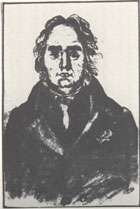Gerhard Friedrich Müller

Gerhard Friedrich Müller (Russian: Фёдор Ива́нович Ми́ллер, Fyodor Ivanovich Miller, 29 October 1705 – 22 October 1783) was a historian and pioneer ethnologist.
Biography
Müller was born in Herford, while he was educated at Leipzig. In 1725, he was invited to St. Petersburg to co-found the Imperial Academy of Sciences. Müller participated in the second Kamchatka expedition, which reported on life and nature of the further (eastern) side of the Ural mountain range. From 1733 till 1743, nineteen scientists and artists traveled through Siberia to study people, cultures and collected data for the creation of maps. Müller, who described and categorized clothing, religions and rituals of the Siberian ethnic groups, is considered to be the father of ethnography.
On his return from Siberia, he became historiographer to the Russian Empire. He was one of the first historians to bring out a general account of Russian history based on extensive examination of documentary sources. His accentuation of the role of Scandinavians and Germans in the history of that country – a germ of the so-called Normanist theory – earned him enmity of Mikhail Lomonosov, who had previously supported his work, and dented his Russian career. In 1766, after many attacks by his colleagues, was appointed keeper of the national archives. He drew up for the government a collection of its treatises.
In 1761, Müller was elected a foreign member of the Royal Swedish Academy of Sciences. He died, aged 77, in Moscow.
See also
Notes
References
- Kerstin Holm, Stuttgarter Zeitung, No. 303 (29 December 2005), p. 38.
-
 This article incorporates text from a publication now in the public domain: Gilman, D. C.; Thurston, H. T.; Colby, F. M., eds. (1905). "Müller, Gerhard Friedrich". New International Encyclopedia (1st ed.). New York: Dodd, Mead.
This article incorporates text from a publication now in the public domain: Gilman, D. C.; Thurston, H. T.; Colby, F. M., eds. (1905). "Müller, Gerhard Friedrich". New International Encyclopedia (1st ed.). New York: Dodd, Mead.
Further reading
- Joseph Lawrence Black, G.F. Müller and the Imperial Russian Academy of Sciences, 1725-1783: First Steps in the Development of the Historical Sciences in Russia. Kingston-Montréal: McGill-Queen’s University Press, 1986.
- Joseph Lawrence Black and Dieter K. Buse, G.-F. Müller and Siberia, 1733-1743. With translations of German materials by Victoria Joan Moessner. Kingston, Ontario/Fairbanks, Alaska: Limestone Press (Russia and Asia Series 1), 1989.
- Aleksander Christianovich Elert, Ekspedicionnye materialy G. F. Millera kak istocnik po istorii Sibiri [Expedition Materials of G.F. Müller as Sources for the History of Siberia]. Novosibirsk, 1990. ISBN 5-02-029627-9
- Gudrun Bucher, "Von Beschreibung der Sitten und Gebräuche der Völcker": Die Instruktionen Gerhard Friedrich Müllers und ihre Bedeutung für die Geschichte der Ethnologie und der Geschichtswissenschaft. Stuttgart: Franz Steiner Verlag (Quellen und Studien zur Geschichte des östlichen Europa 63), 2002.
- Ludwig Stieda (1885), "Müller, Gerhard Friedrich von", Allgemeine Deutsche Biographie (ADB) (in German), 22, Leipzig: Duncker & Humblot, pp. 547–553
- Claus Priesner, Müller, Gerhard Friedrich von. Neue Deutsche Biographie (NDB) 18 (1997), S. 394 f. On-line edition: http://www.deutsche-biographie.de/pnd118953362.html
- Peter Hoffmann, Gerhard Friedrich Müller (1705-1783): Historiker, Geograph, Archivar im Dienste Russlands. Frankfurt am Main: Peter Lang, 2005.
- Gerard Fridrich Miller [Gerhard Friedrich Müller], Opisanie sibirskich narodov. [Beschreibung sibirischer Völker]. Edited by Aleksandr Christianovich Elert and Wieland Hintzsche. Moskva: Pamjatniki Istoricheskoj Mysli (Quellen zur Geschichte Sibiriens und Alaskas aus russischen Archiven Band VIII/1), 2009.
- Gerhard Friedrich Müller, Ethnographische Schriften I. Bearbeitet von Wieland Hintzsche und Aleksandr Christianovich Elert unter Mitarbeit von Heike Heklau. Halle: Verlag der Franckeschen Stiftungen zu Halle, Harrassowitz Verlag in Kommission (Quellen zur Geschichte Sibiriens und Alaskas aus russischen Archiven VIII), 2010. ISBN 978-3-447-06402-6. Band I: Beschreibung der sibirischen Völker [ca. 1736-1747].
External links
 "Müller, Gerhard Friedrich". The American Cyclopædia. 1879.
"Müller, Gerhard Friedrich". The American Cyclopædia. 1879.
- Carl von Linné; Gerhard Friedrich Müller. "Correspondence".